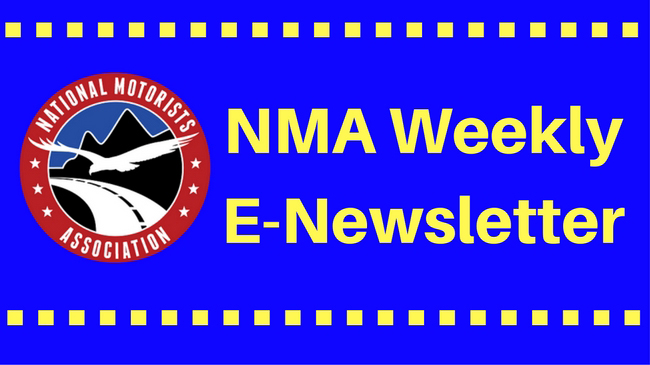
The need to advocate for motorists’ rights has grown during the time of COVID. NMA members need to be more vigilant than ever in home communities and home states.
This newsletter is a two-parter and comes from what we see trending nationally. This week, we look at speed limits, automated traffic enforcement, and street surveillance. Next week, the focus will be on police reform, infrastructure, tolls, and some positive things we see coming down the pike.
We would like to hear your views on what’s next. Please email us at nma@motorists.org.
Speed Limits
Before the current world health crisis, cities and towns were under pressure by Vision Zero and anti-car proponents to lower limits without regard for natural, safe driving speeds. The 85th percentile continues under critical review at all levels of government. The carcass of the 55 mph National Maximum Speed Limit even seems to be rising from the dead as calls for reinstitution of a federally mandated restrictive limit are growing.
Ironically, the Center for Disease Control announced at the end of May that personal vehicles are currently the safest way to get around in the current pandemic and after the country completely opens. (Of course, the agency later retracted this recommendation after pressure from anti-car activists.)
Automated Traffic Enforcement (ATE): Red-Light and Speed Cameras
Many cities have echoed the camera company party line in declaring ATE as a vital safety tool when it is no secret that the revenue from photo tickets is often a budget balancer for them. The coronavirus jolt to the economy may cause more cities to look at the deployment of cameras to fill budget gaps.
Several new types of automated cameras are becoming available as part of the policing tool chest. Green-light cameras combine red-light and speed camera technologies. Distracted driving detection cams mounted along roadways primarily detect whether a driver is using a cell phone while the vehicle is in motion. The Australian state of New South Wales began using the detection cameras this year. In the first two months of operation, more than $7.1 million in fines were issued to 21,000 drivers, or roughly the equivalent of 5 million US dollars.
Street Surveillance: Automated License Plate Readers, Surveillance Cams, Facial Recognition, Contact Tracing Apps on Phones, Drone and Airplane Surveillance
Big Brother and Sister are here, and they are not going away.
Automated License Plate Reader (ALPR) and Other Surveillance Cameras
Many cities around the country are either funding mobile (police vehicle) ALPRs or are putting the devices at the entrances and exits to their towns. Neighborhood groups now also use ALPRs, closed-circuit cameras, and personal Ring doorbell cameras to track traffic in and out of their subdivisions. Police ALPR use will only increase. Same with surveillance cameras, especially with civil unrest used as justification.
Facial Recognition
Facial recognition devices constitute the surveillance technology of choice in China. In the US, while privacy rights groups and even cities have started pushing back against rights violation issues surrounding the use of facial recognition as an enforcement tool, its implementation for identifying and tracking individuals on the streets and in their cars is on the rise.
Data gathered from facial recognition are already connecting to databases that contain personal information and biometrics gleaned from state DMVs. Privacy safeguards are not apparent.
The American Civil Liberties Union (ACLU) recently filed a lawsuit against Clearview AI, a facial recognition company. Clearview allegedly collects and stores data without the owners’ knowledge and sold access to the data to other private companies and law enforcement. More privacy lawsuits like this will likely be filed against opportunistic companies in the future.
Facial recognition will become more important in the sharing economy, especially as a way to identify paying customers for rideshare and mobility services (that is if either come back to life after the pandemic).
Phone and Contact Tracing
Private companies are already tracing your movements by utilizing various apps that use location tracking. Do you use a weather radar app? The app needs to know where you are to give you the information about the local weather. That is a trace. Compound that with all the other phone apps that ask for your location—you get the picture.
As part of the surveillance response to the COVID-19 crisis, Apple, Google, and many other tech companies around the world are working on contact tracing apps. These phone-based programs will be used to show if you have the COVID-19 virus and will attempt to track all the people you came in contact with so that they can be tagged too. Coupled with thermal imaging cameras and other types of surveillance, you are likely to be tracked everywhere you go. Contact tracing apps have already been used to follow recent protesters.
Drone and Plane Surveillance
Police and other government agencies are using drones for various reasons: accident reconstruction, active shooter incidents, and other active incidents to gather intelligence. This includes using drones during recent protests.
Overhead surveillance by aircraft is being used in cities like Baltimore. The ACLU recently launched an ad campaign to advocate against the practice. Highway speed surveillance by plane will likely continue wherever allowed.
Of course, the future is not fixed. Many events can happen in a short time, such as what has happened in the past month in the wake of George Floyd’s death in Minneapolis. The subsequent worldwide protests and civil unrest are prime examples.
Next week in Part 2 of What’s Next for Motorists’ Rights, we will delve into police reform, infrastructure, and other possibilities that motorists’ rights advocates will welcome.



